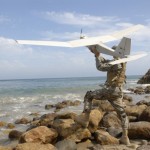Launch This New 9-Hour Solar-Powered Drone from Your Shoulder
Launch This New 9-Hour Solar-Powered Drone from Your Shoulder
A new small unmanned aircraft system (UAS) boasts something no other has been able to do thus far: continuous flight for 9 hours and all on the clean energy of solar power.
AeroVironment‘s 13-pound Puma AE can be assembled and hand-launched in minutes and requires no infrastructure for launch or landing, making them attractive for frontline use where time and space can be too scarce for the requirements of full-scale drones.
And while it may be some time before the Pentagon is showing off solar-powered tanks, AeroVironment insists these types of solar technology advancements are indispensable for the military.
“This is a critical milestone with far-reaching implications for the many ways small UAS can benefit military, public safety and commercial customers,” said Roy Minson, senior vice president of the Monrovia, CA-based AeroVironment.
AeroVironment enlisted the help of Alta Devices for its proprietary, ultra-thin solar cells. Past attempts to attach solar power to small UAS were either too heavy or couldn’t produce enough power for long-range flights but, according to Minson, recent tests prove that the solar Puma AE technology ”can produce enough power, while adding negligible weight, so that endurance is no longer an issue for most customer missions.”
“Our integration of this cutting-edge technology dramatically increases Puma’s current flight endurance using a clean, renewable power source,” said Minson. “This development can give Puma AE customers significantly increased capabilities that approach those of the next class of UAS at a much lower acquisition and operating cost, and with much greater operational flexibility.”
Last month, the Federal Aviation Administration gave the Puma AE a “Restricted Category” certification, which permits commercial operators to fly the UAS in the regions of the Arctic. It was previously not permissible to operate drones in national airspace for commercial purposes.
“Aerial observation missions can now be safely accomplished in hazardous Arctic locations, which will reduce the risk of manned aviation in an efficient, cost-effective, and environmentally friendly manner,” said Tim Conver, AeroVironment chairman and chief executive officer, at the time.
Got something to say? Click here to reply










